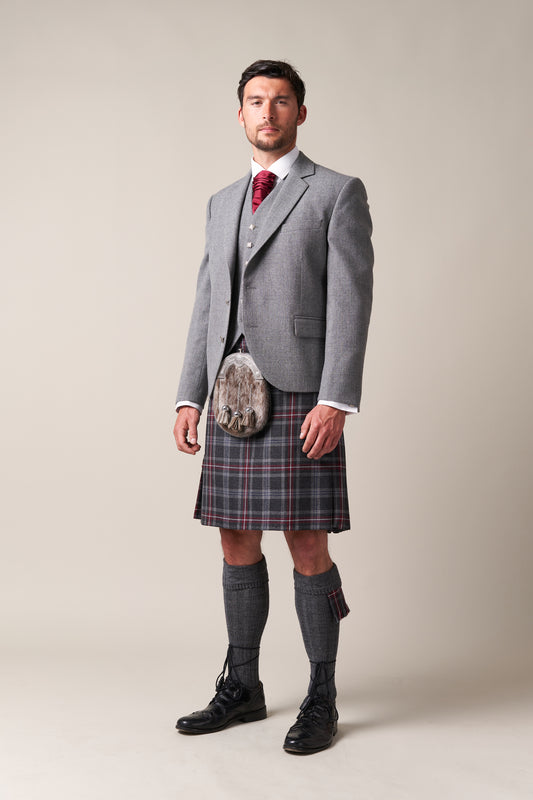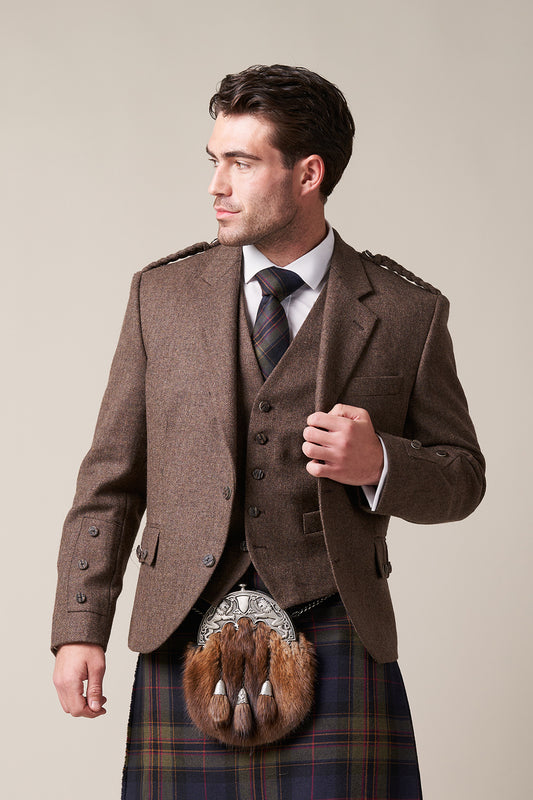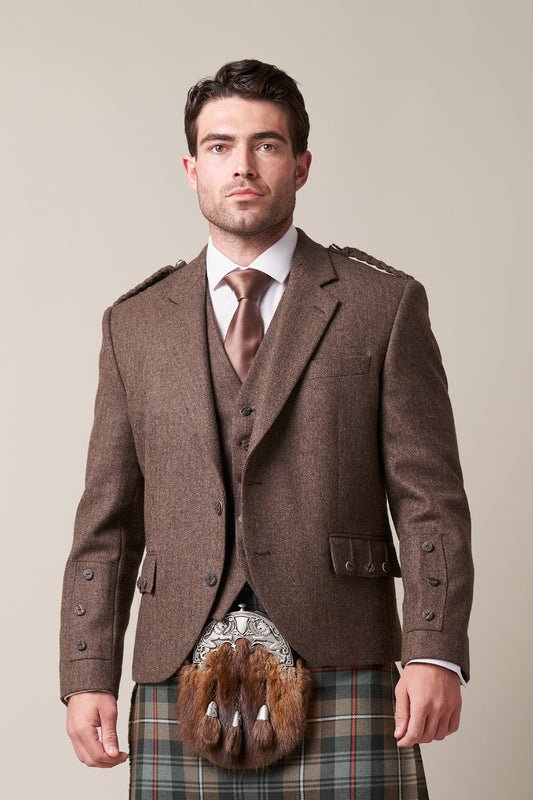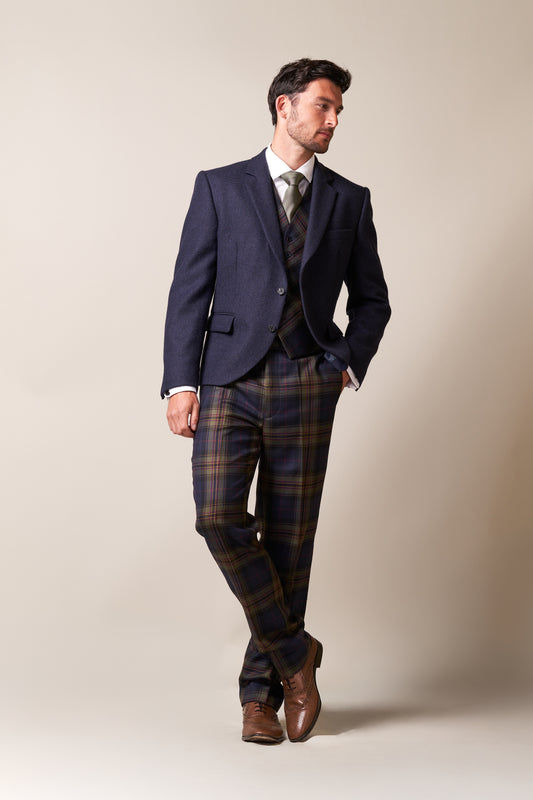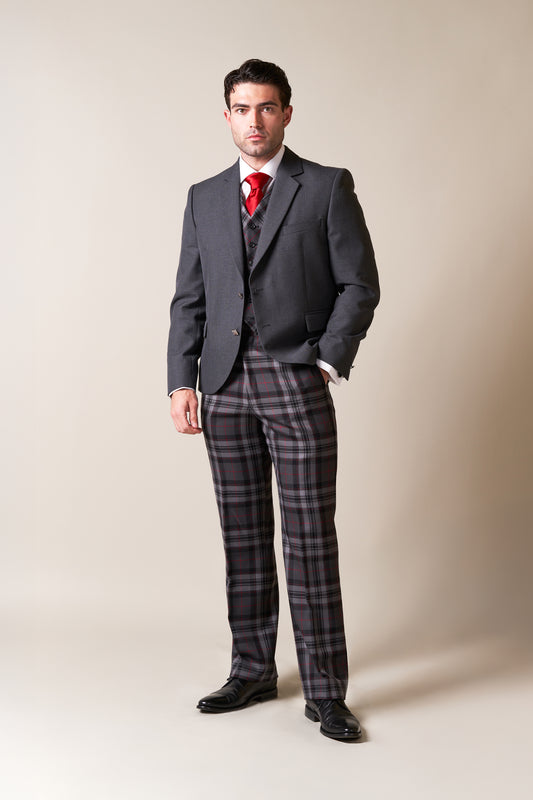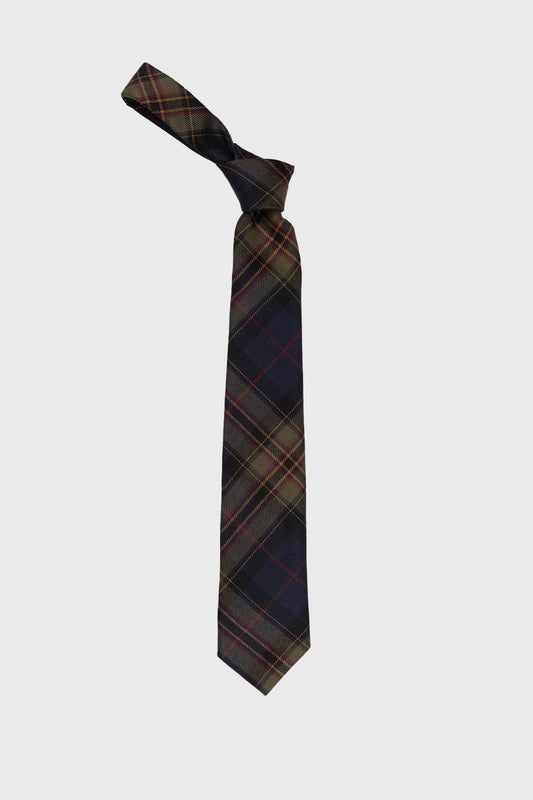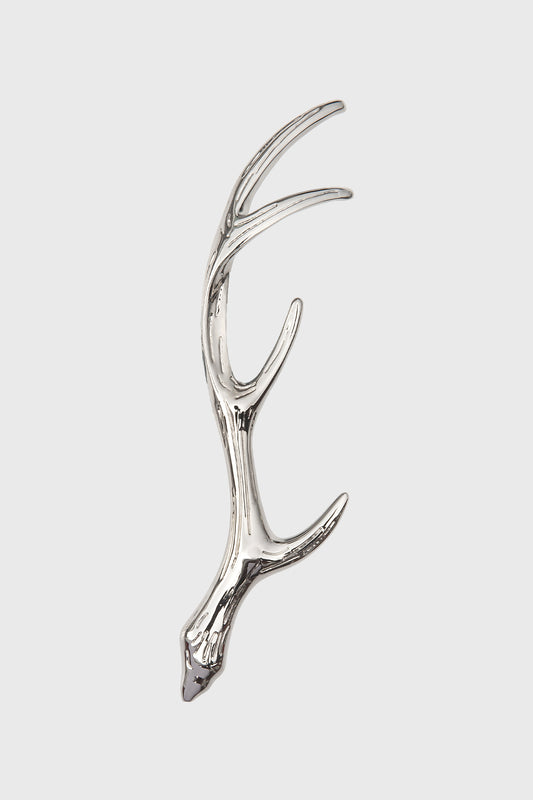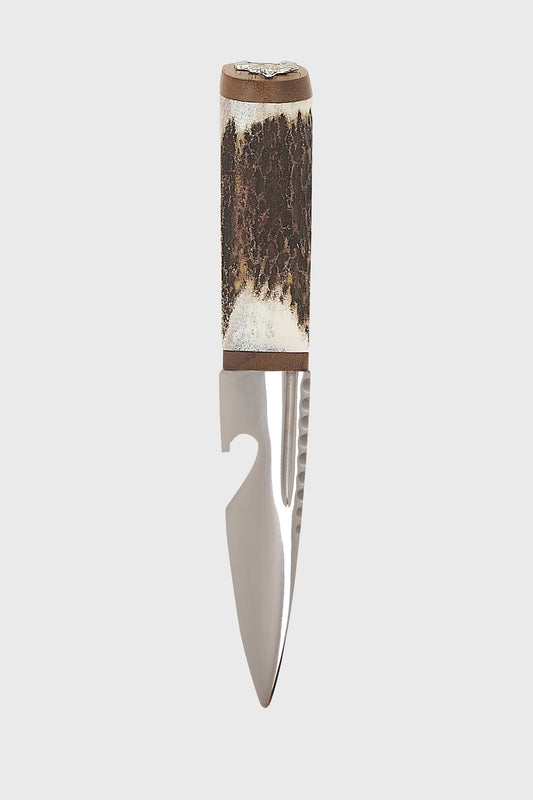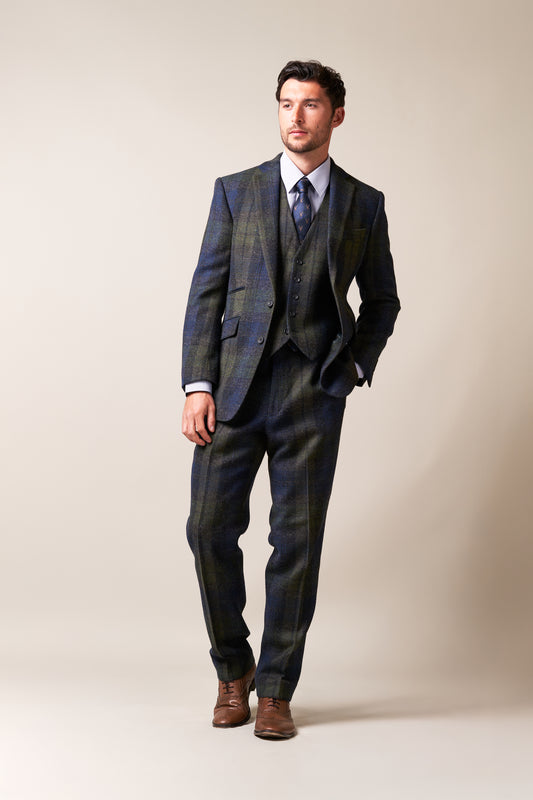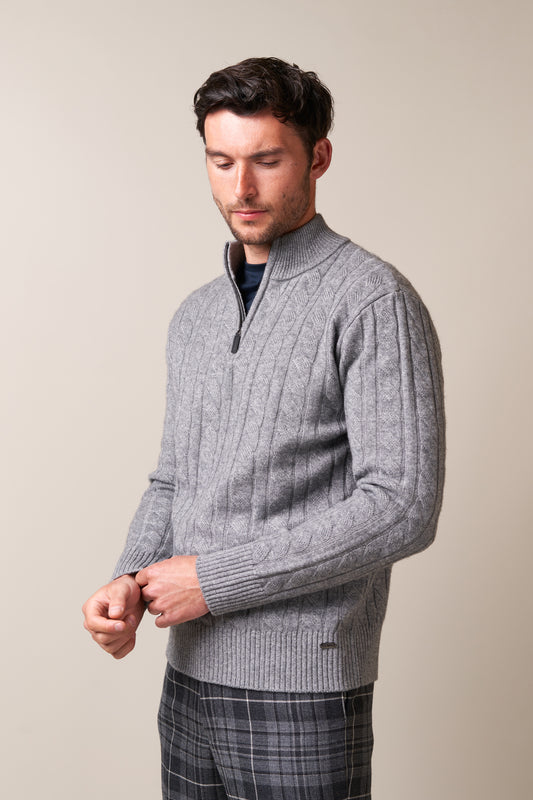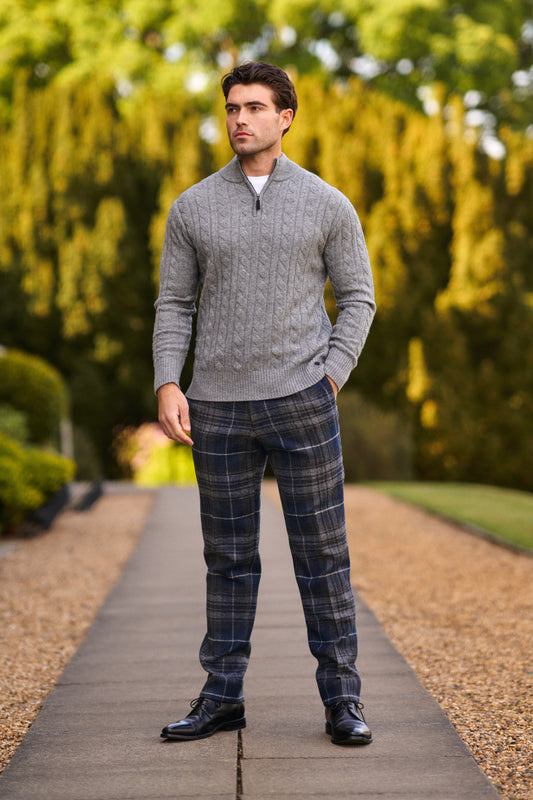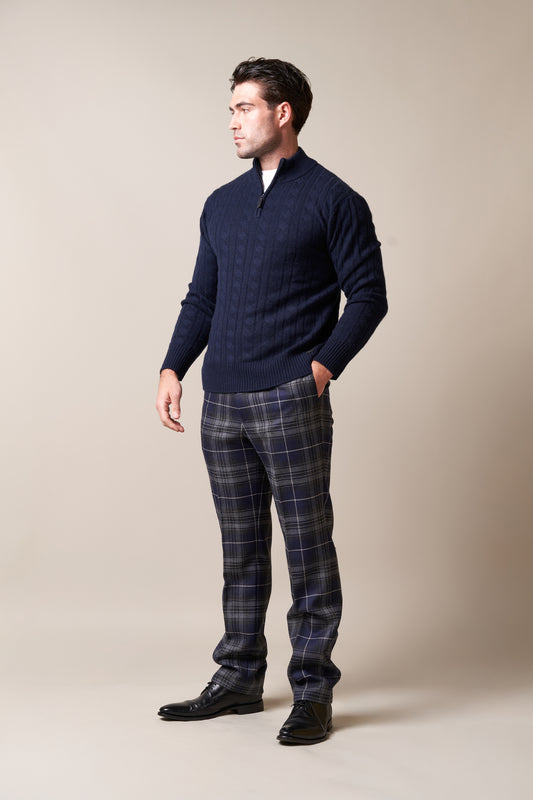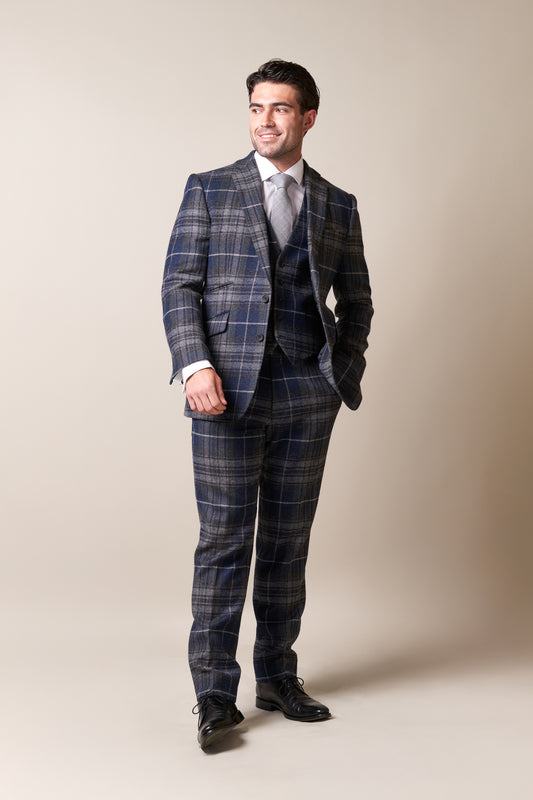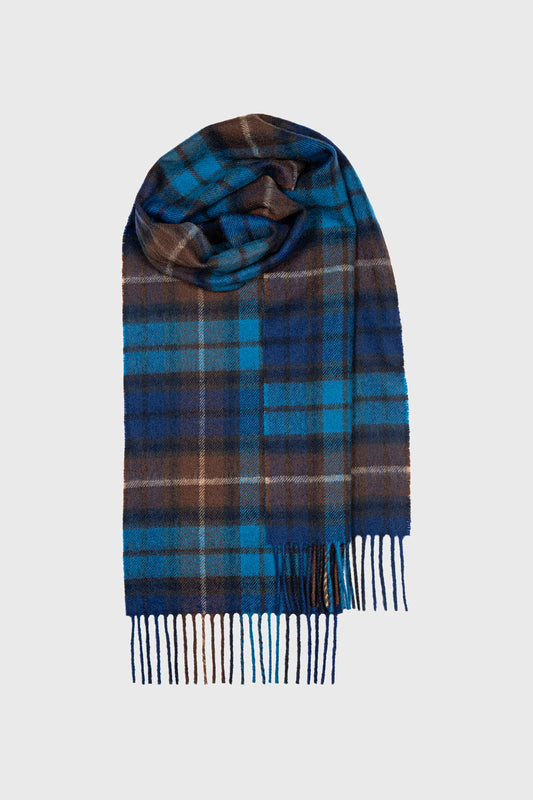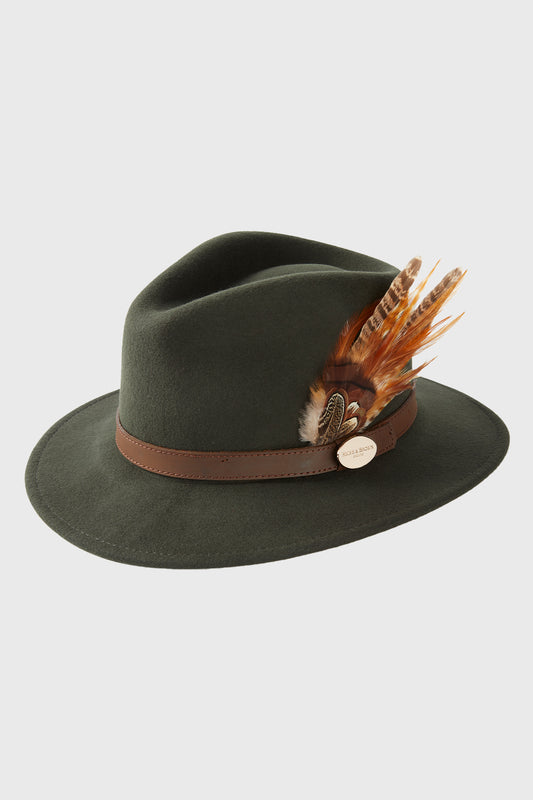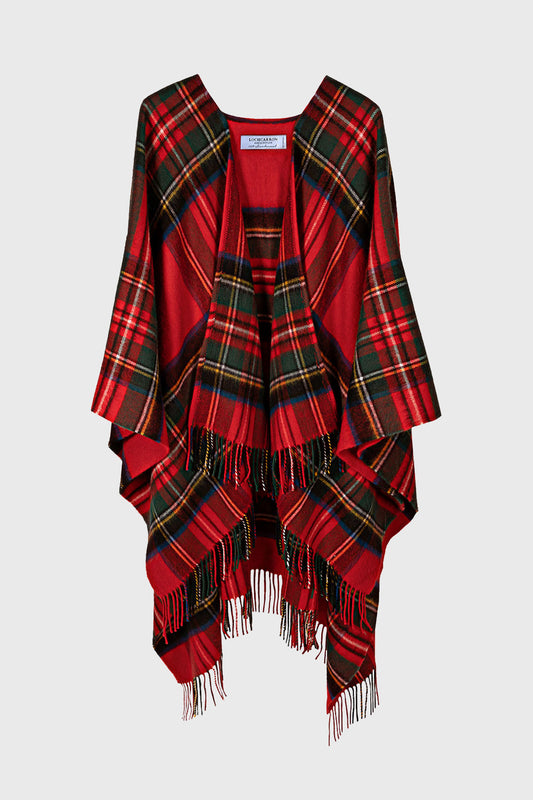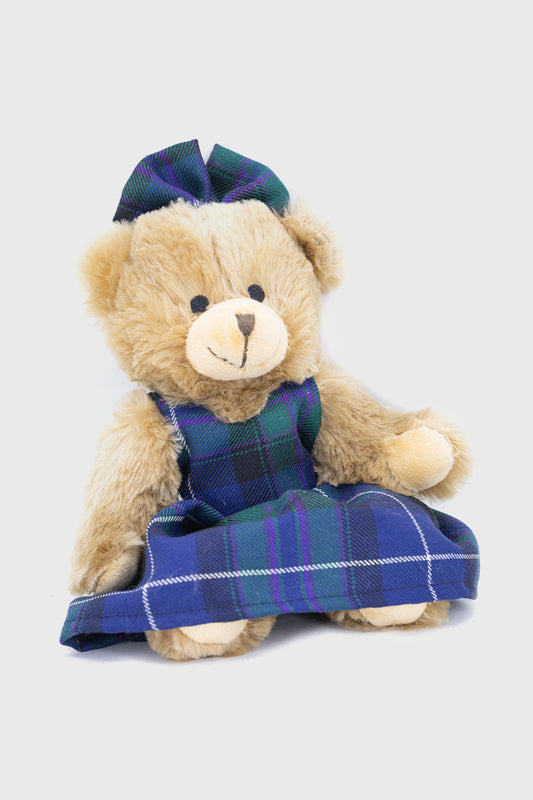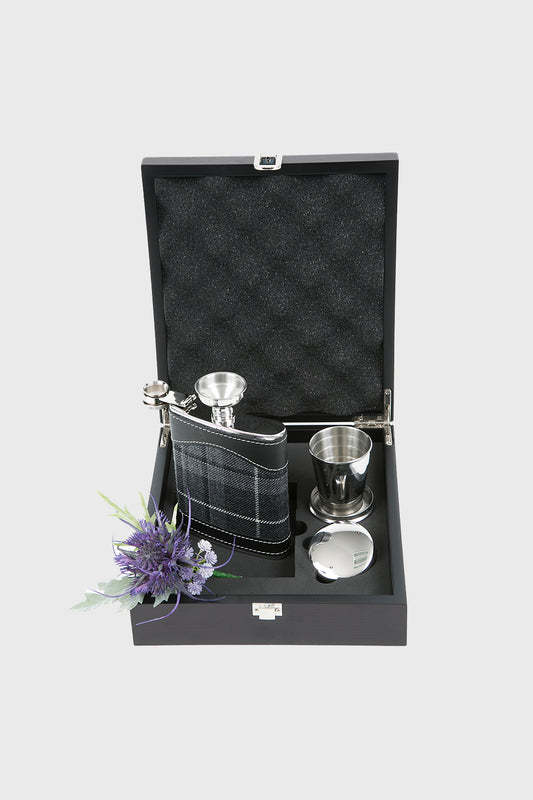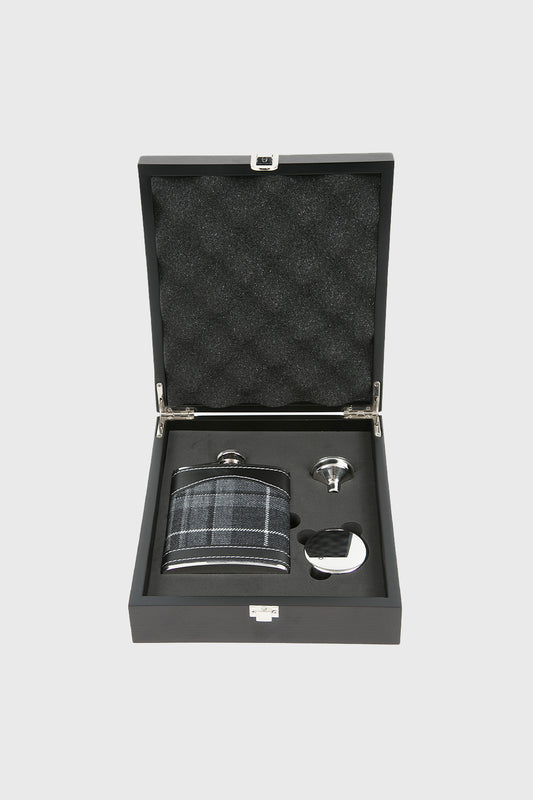News
News
Behind the Fabric; Know the Difference Between Tartan and Tweed
When it comes to Scottish style, two fabrics often steal the spotlight: tartan and tweed. Both are rich roots in the endless Scottish tree, but what actually are they? And are they just the same thing in different fonts?
Well, no. But that’s why we’re here. So sit back and get ready to scroll as we’re away to expand your knowledge of Scottish fabrics one thread further: here’s everything you need to know to distinguish tweed from tartan.
What Is Tartan?
The easiest foot to start upon is this: tartan is a pattern, not a fabric. It’s defined by its distinct criss-crossed horizontal and vertical stripes in multiple colors. These patterns and colours are distinct to every individual tartan, and these colours and strips form a ‘Sett’.
As you may know, tartan has been around in Scotland for centuries and was notably worn by Scottish clans a few centuries ago. Nowadays, tartan can be worn for any occasion your heart deems it to, but is most commonly worn to formal and special events like a traditional Scottish wedding.
Tartan is no longer just reserved for Scotsmen though, as many fashion designers like Vivienne Westwood, Alexander McQueen and Dior have been known to use a huge amount of Scottish influences within their work. Dior even held their 2025 Cruise Show last year in Scotland with tartan everywhere you looked (see our blog; Styling Scotland; The 2025 Dior Cruise Show for more details).
Tartan is also often associated with bright and bold colours that ensure a stand out look for everyone. As well as this, tartan is woven in a range of materials like wool, cotton and synthetics.
What Is Tweed?
Tweed, on the other hand, is a fabric, not a pattern. It’s a rough, durable, and often heavyweight woolen textile, originally developed in Scotland and Ireland as a practical material for outdoor wear. Designed to withstand the harsh weathers and rugged terrains, tweed is tightly woven and traditionally dyed in earthy, muted tones to blend into natural landscapes, much like that of weathered tartans. Tweed is normally formed in a twill weave and is made from wool. For a Scottish company who are rocking the tweed game, look to the Harris Tweed Authority. They have been forerunners in tweed since 1846 and have many beautiful tweed pieces (some of which are available within our stock.
Tweed is commonly used in tailoring, think structured blazers, tailored trousers, and country coats, and it often features subtle patterns such as herringbone, houndstooth, or checks.
Tweed is also infamous for being used in traditional British tailoring, and have often been used in resemblance to old money, country living or academia.
The Mix Up
So if tweed and tartan are so different, how do they get mixed up? Well due to the fact you can get tweed tartans!
Tweed tartans are tartans that are woven in those more durable materials and the traditional setts of the specific tartan but exist in those muted and earthy hues that tweed is infamous for.
Pair the two together and you end up with a new variation of your favourite tartan that is rich with a new set of textures and shades that will have everyone stopping you to ask what kind of tartan it is!
Tartan Unravelled: Exploring the Differences in the Scottish Setts
Tartan on the Brain
We’re no strangers to tartan at McCalls Highlandwear; our stores are filled, top to tail, with colourful Setts and woollen wonders. But even with our extensive collection, we don’t even begin to scratch the surface of the reportedly 4,000+ tartans that are said to exist!
It can get quite confusing with all these different colours, names, and types. There are Clan Tartans (like Stewart and Irving), Clan Area Tartans (such as MacDonald of the Isles), Place Tartans (like the official Aberdeen or Glasgow Tartans), University Tartans (including the Edinburgh University tartan), and tartans that have no connections but have rather fun names (Rolling Thunder and Leaping Salmon are popular choices).
And on top of that, you have multiple variations of the same type! And what exactly are the differences between all of them? Will you notice a difference between Patriot Weathered and Patriot Modern?
Well, scroll down further for the next instalment in our blog series and discover what each variation of tartan means.
What are the Variations?
We’ll cover the five most popular and asked-about tartan types: ancient, Modern, Hunting, Weathered, and Dress. These different variations are also known as ‘Colour Ways’.
Ancient Tartans
As you’ll come to learn, names like ‘Ancient’ have nothing to do with the actual age of the tartan. In fact, you can buy an Ancient MacKay kilt that has just been woven in the previous weeks!
So what actually makes a tartan have an Ancient colourway?
As we know it, tartan became popular in the 16th century when highlanders wore it to separate themselves from different clans. The dying abilities in this time period were not nearly as broad and capable as today's, so fabrics were coloured using whatever was available. Scots of the time used natural items like plants and animals to colour their tartans. The diverse range of foliage, in turn, ensured that separate Colourways were formed, although they initially had only a few viable combinations.
The invention of chemical dyes replaced this traditional style. Ancient styles are also brighter than their darker Modern Tartan counterparts. Still, the essence of the colours has now been replicated with modern dyes to try and create tartan similar to that of the great Highlanders.
See some of the best examples of ancient tartans above & below.
Modern Tartans
These tartans are named for the modern colours they exhibit.
Modern Tartans emerged with the invention of chemical dyes in the 1800s. This meant that dyes became much more saturated and bolder. These new dyes reinvoked national interest in the kilt and Scots identity, as Queen Victoria herself took a shine to them.
Queen Victoria held a deep affection for Scotland as a whole, but her heart especially belonged to the Highlands. There, she quickly fell in love with the rolling landscapes and regality of the region.
Victoria was the monarch who first set her sights on Balmoral Castle and, alongside Albert, often retreated to the Deeside estate for a quick escape. They embraced their love for what they considered traditionally Scottish, often dressing their children in kilts, serving porridge, and living in a newly tartan-decorated Balmoral Castle.
This allowed the strong and vibrant hues of the now-named ‘Modern’ tartans to shine and foster a love for tartan today, mirroring the Victorians' appreciation for colour. From there, many more clan tartans in an array of colours were introduced. Modern Tartans, today, are rich and saturated, serving as a delightfully dark counterpart to the more muted ancient tartans.
See some examples Modern tartan colourways above & below.
Hunting Tartans
Hunting Tartans are, much like the name suggests, named for hunting.
These tartans feature colourways rich in earthy tones, making it easier for clansmen to blend into the sprawling Scottish foliage when hunting for food.
Often rooted in strong natural hues like deep greens, browns, and navy, these shades serve as perfect tributes to Scotland and provide an excellent way to express your pride. Below are some of the best examples of hunting tartans in our catalogue.
Weathered Tartans
Weathered by age is an excellent indicator of the colour scheme within this particular tartan colourway!
Weathered tartans bring back the muted quality of an Ancient tartan and amplify it. There are many different and great iterations of why weathered kilts and tartans are relevant to the Highlander state of mind. Some people say that the faded tones are meant to be as if some long-ago kilt from centuries past has been found in the ground and has been discovered with the colours bleached by the age of time.
These hues reflect what might have occurred to the Highlanders' kilts in the notorious Scottish climate, given their long hours spent outdoors hunting and riding. The colours faded in the sun and were soaked by the rain, embodying the name' Weathered. '
Weathered tartans feature the same core colourways as their Modern and Ancient equivalents but are faded, making them a great canvas for accessorising any special event.
Dress Tartan
The dress variations of your favourite tartans were, as the name suggests, often used in place of ‘dressier’ occasions. This would be for formal events like awards ceremonies or competitions requiring a formal level of dress like in Highland Dancing.
Dress tartans feature much more white than your average tartan. This colour palette brings light to a tartan, transforming it into a new look perfect for standing out on stage.
While Dress tartans bring up the least variations, some examples can be found above & below.
Putting Kilts on the Map: International Tartan Wearers
The McCalls Name
It has been over 135 years since McCalls Highlandwear was established in the heart of Scotland’s granite city. Since then, we have expanded nationwide, with our flagship store on Aberdeen’s Bridge Street and six other locations in Scotland’s largest cities. Our doors are open to all who love and appreciate tartan.
We’ll answer some of our most frequently asked questions in this new blog series.
First up: Is it okay for non-Scots to wear a kilt?
The Short Answer: Yes!
A Brief History
The kilt has long been a symbol of Scottish freedom and patriotism. From the 16th century, the kilt has represented Scottish freedom and patriotism, having been worn to battles (although notably not in the style of kilts of the time were more like the ‘Great Kilt’) or donned by government troops like the Independent Highland Company. At least until the Jacobite rebellion was crushed and the essence of Scottishness was forcefully eradicated by the 1746 Highland Dress Act.
This Act sought to suppress Scottish culture by banning all things Scottish, including our dress and language, and even the kilt. But despite efforts to erase our heritage, the kilt has endured, reclaiming its place as a symbol of Scottish identity.
Who Can Wear Tartan?
At McCalls Highlandwear, we have customers from all over the world who want to celebrate Scotland’s rich history and culture. Many visitors to Scotland purchase a kilt as a unique, authentic souvenir. And why not? There’s nothing better than owning a dapper kilt crafted in the heart of Scotland!
Our tartan collection is extensive, offering something for every taste. We even have exclusive McCalls tartans that honor other nations, like the Irish Pride and Welsh Pride tartans, so that you can celebrate your roots with a Scottish flair.
As a country whose identity has been fought for and preserved, we encourage anyone who loves Scottish heritage to wear Highlandwear proudly. And if you can’t fit a weighty woolen kilt in your suitcase, no worries, as we offer worldwide shipping so you can put kilts on the global map!
Short, Sweet n’ Tartan
Sabrina Carpenter Donned a Terrific Tartan at her Glasgow Concert!
The Unveiling
If you’re anything like us, you’ve been following the Sabrina Carpenter tour like it's a brand new ‘Roman Empire’! Between squinting to see the latest quote on her tights, keeping up with all the ‘Sabrina Updates’ on TikTok and seeing the infamous ‘Juno’ Position from all angles.
And let's not forget to mention the unveiling of every new body suit at the show's start!
So, when her recent concert at the OVO Hydro in Glasgow crept closer and closer, we all waited with baited breath.
Brand new bodysuits had been recently debuted at her Dubin and London Night One shows (Emerald Green and the Union Jack, respectively), so the anticipation was mounting.
And then, to all of our wee Scottish Hearts delights, she stepped out to the roar of a sold-out crowd and unveiled…
TARTAN!
Bedazzling and Brilliant, her newest bodysuit was unveiled to feature a dark and decadent tartan. Hues of deepest Indigo and Plum came together to create a shimmering Scottish dream, perfect for her one night in our country’s biggest city!
The Tartans
Since the show on Tuesday, we’ve scoured our tartan collection to try and find a tartan like Sabrina’s for all the Short n’ Sweet fans to rock (maybe for the next time she visits!).
While none are exact as the item was custom and not an official tartan, we’ve formed a decent selection so you can stun like Sabrina (minus the sparkles, unfortunately).
Elliott Ancient Old & Rare
While the sett isn't the same, the House of Edgar Old & Rare version of the Elliott Ancient tartan keeps the colours just right. With a beautiful combination of deep red and blue hues.
Exclusive Modern Pride of Scotland
With more blue and purple, our exclusive Modern Pride of Scotland is a close match. The deep blue and purple colour lends itself perfectly to the dark hues on Sabrina’s bodysuit. The tones are very similar to Sabrina's, with the added extra of a white stripe to symbolise the saltire.
Navy Highland Granite
The Navy Highland Granite is a tartan full of blues and purples that will make matching Sabrina as easy as cake. A classic array of navy and cerulean come together to form this terrific tartan, and a shot of white throughout creates an ode to our very own Saltire flag. This way you can pay homage to your favourite Busy Woman while remaining firmly Scottish!
Scotland Forever
For the purple lovers out there, we would recommend the Scotland Forever tartan. A lighter look would be the outcome of this tartan, and what a look it would be! While bedazzling isn’t our strong point, we know this one would look brilliant in sparkles! Lilac is a key colour focus, with a pop of cyan to finish it off! This would create the most brilliant of outfits.
Spirit of Scotland Modern
Straying away from the red hues, the Spirit of Scotland tartan is the perfect pop of colour to Sabrina’s deeper hues. Heather purple dances amongst shades of the subtlest touch of emerald green. Add the most amazing Azure blue and have the most lovely blue and purple tartans!
Montgomery Modern
This tartan will sure be hard to bejewel! Violet is the key colour component here on the Montgomery Modern tartan, and while Carmine and Moss hues certainly try to steal the spotlight, purple reigns supreme, making it the perfect look for any concert in the heart of Scotland.
Between the tartan bodysuit and her new Baby Doll shift in purple with a green trim that plays upon Scotland's national flower—the Scottish Thistle—we couldn’t be happier with Sabrina’s homage to Scotland!
Head to our website to get in our Good Graces and discover the tartans above to live out your very own Short n Sweet show from home! Don't forget, tartan comes in many forms, we of course have our kilts and trews, but we also offer accessories like ties, hip flasks and scarves, as well as full customised options like waistcoats and jackets, ladies blazers, skirts and more!
We all wait to see the rest of the outfits as she visits more of the UK and Europe!
Styling Scotland; The Dior 2025 Cruise Show
Terrific tartans were the centre point of the 2025 Cruise show by Dior in the heart of Scotland
Initially created as a means of giving the wealthy customers of the fashion Houses ready to wear summer outfits for vacations in the heart of winter, as time has gone on Cruise shows have been hosted across the globe! Held in the off-season between the Autumn/Winter and Summer/Spring collections, the Houses have now started hosting these Cruise collections to clients who live in these destinations or the clientele who actually live there. These shows also allow the Houses to work with and showcase the local talent within these countries to create a series of compelling collaborations that may have never been seen before.
Diors choice to host this show in Scotland on June 3rd of 2024, highlighted gorgeous aspects of Scotland’s history as well as the wonderful work of local Scottish businesses and designers, like Samantha McCoach of ‘Le Kilt’. The current creative director of Dior, Maria Grazia Chiuri, has aimed to highlight the different types of craft across the globe and with this past show she did an amazing job. The choice also reflected the brand's history with Scotland, playing upon Christian Dior’s own unexpected love for the country (a look in his sophomore collection was entitled ‘Ecosse’). But this also strengthens the idea of the collection, with the inspiration Mary Queen of Scots also being a Queen of France!
Celebrities like Jennifer Lawerence and Anya Taylor-Joy flew into Edinburgh and sat on tartan covered benches in the gorgeously scenic grounds of Drummond Castle in the heart of Perthshire as an ode to Scotland in all forms walked before them!
The History
Dior’s history with Scotland began all the way back in the 1950s by Christian Dior himself. The connection is especially strong to Perthshire in particular as this was where Mr Dior unveiled the 1951 Spring-Summer collection, making it the undoubtedly perfect place for Chiuri to host this past collection, following in the footsteps of Dior himself.
For this show in particular, Chiuri drew inspiration from an undoubtedly iconic member of Scotland’s history, Mary Queen of Scots. A great deal of the silhouettes and creations within the show are almost ‘punkified’ editions of Tudor inspirations that have been brought into the modernism ideas of fashion.
A 90s esque red and black tartan was walked alongside a complete contrast of historical references - intricate floor length gowns, embroidered bodices that are a direct inspiration from Mary Stuart herself (see; Embroidering Her Truth: Mary, Queen of Scots and the Language of Power by Claire Hunter that Chiuri cited for reference) and a delicate silver netting reminiscent of chainmail - to play upon the traditional history of Scotland while also referencing the brutality of that Tudor age.
Many of the accessories are older in aesthetic (or have older references) but feature modern twists like a choker with yellow gold charms dangling from the piece or a traditional Glen Garry piping hat being embellished with delicate pearls.
And while the entire collection was full of amazing pieces, the star of the show for us at McCalls Highlandwear were easily the tartans!
The Tartans
The tartans used within this show are a great play upon the core themes of the show Dior were trying to convey. According to Grazia, Chiuri “found a tartan check in the Harris Tweed archives and worked with them to recreate it in a yellow and purple check that reminded her of the gorse and heather you see across the ‘cinematic’ Scottish landscape”. This takes an ‘ancient’ item or aesthetic and brings it into the modern day with a gloriously punkish Parisian twist, making it undoubtedly the perfect pieces for this collection!
The show kicked off with a series of purple tartan outfits. From tailored jackets, off the shoulder dresses and even to intricately panelled pieces reminiscent of armour, the deep heather hues within this tartan are something to marvel at. Enhanced by the beautiful botanics of the grounds of Drummond Castle, this was a dark based tartan that is the complete opposite of all images of summertime, yet it worked beautifully. The additional shades of black and lilac within come together to pull off those punkish themes and Scottish traditionalism perfectly.
The first piece of the show is a special showcase of this as it emulates the styling of the ‘Great Kilt’ (see: our ‘The History of The Kilt’ blog post) beautifully, with a wide neckline and a movement to the fabric, amongst like it had just been slipped on (though we all know that is certainly not the case!).
Part of the undeniable beauty of the hues of this tartan means it is hard to find a perfect match!
However we believe we at McCalls have found two of the closest that also allow you to add your own spin upon them! The Highland Mist tartan is a great start as it features the beautiful decadence of the duality of purples present within Dior’s own, yet a white overcheck brakes up the shades perfectly!
Otherwise the Scotland Forever Modern Tweed tartan could be a great option as it once again has the gorgeous shades of rich purple present within yet features a great deal more of white in an overcheck. The white almost emphasises the purples more and creates a lovely tartan!
The next tartan to be showcased is a ‘more traditional’ looking tartan! Based in deep crimson red, this tartan is what everyone thinks of when you picture Scotland. The white overcheck adds a pop against the dark red and black, breaking up those darker shades for a breath of fresh air. Once again this is a more autumnal hued tartan, but it perfectly evoked those thoughts of ‘punk’ that the designers were evidently inspired by.
The red tartan has been styled much more contemporary than the purple making it more wearable in some cases. The purple looks featured more avant garde elements that had clear inspirations of traditional Scotland, while the red tartan has been treated completely differently. It still has those elements of high fashion that the mere image of Dior embodies in waves, but was treated in a different regard. Some of these looks are paired with graphic tees that are imprinted with imagery of Dior’s previous Scottish shows. The standout (at least in my opinion) is the delicate, Argyll inspired cutout jumper that is paired with a beautifully pleated long tartan skirt, directly influencing the Scottish Kilt (something we here at McCalls know a lot about).
We’ve been scouring our extensive tartan collection and we’ve been able to find two tartans that could embody the perfect Dior Red for you!
The first tartan (and the best match) would have to be Cunningham Modern tartan! The shades line up almost perfectly while the dimensions of the checkers look the most similar! A higher additional amount of red is simply a bonus in the Cunningham Modern!
Or you could go for our second choice of the Inverness Modern which is not an identical match but rings a reminiscent bell to allow you to have your own personal nod to your favourite Dior tartan as the barely noticeable extra colours present with this tartan simply add a delightful depth of dimension from afar!
The third tartan look of the evening was a dark almost mustard yellow tartan that worked perfectly alongside the red. Once more it has the richness of Autumn, though a delicate touch of summertime with those bright hues didn’t go amiss either! The yellow tartan worked best in the lavish lengths of thick material drawn around the shoulders of the models, spilling across the gravel catwalk to steal all the focus in a dramatic vision of Scottish patriotism. The greens of the grass and hedges at Drummond Castle worked beautifully against the yellows in a way you wouldn't see coming, but they brought out a different tone hidden within the fabric to create a gorgeous set of images.
The different textures with this tartan were a really great moment on the eye. From a more armour adjacent outfit where the tartan looks as if it was almost printed upon the fabric which creates a really clean cut and streamlined look, to what looks like woollen and woven floor length shawl that delicately drapes across the shoulder. These two different textures create two almost completely separate looking tartans; one with a brighter more luminous hue while the woollen one appears darker and richer.
If you desire your very own yellow tartan inspired by Dior’s then we would recommend the MacLeod Dress Ancient tartan!
Although not as close of a match as the previous tartans, this one features the same hues of yellow and black as Dior’s with a lovely red overlay for a pop of colour not present within Dior’s!
For an even better match to inspire your own Dior look, than the Barclay Dress Modern tartan is a great find. The bright hues of this tartan almost perfectly match the more concentrated yellows previously discussed to create a warming tartan reminiscent of sunshine!
The white overcheck and black accents break up the intense yellows and offer a great deal of depth and intrigue into the tartan, making it a fantastic choice for any event you wish to stand out at!
The final tartan on the rural runway was one of dark grey. While it may be an unassuming tartan, this doesn’t mean it’s any less wowing than the others! The dark grey has an almost purple shift to it, tying it in with the very first tartan unveiled by Dior. The colours danced under the Scottish skies, the unassuming shades coming to life under a watchful gaze! A delicate touch of red dances between the checkers, breaking up the darker hues to create a gorgeous point of difference.
This tartan was styled as another long homage to the kilt, with a leather belt adorned with silver accents and a cropped asymmetrical leather jacket.
These different textures allow the different shades of the tartan to come forth and shine within their own right, while adding a point of interest within the outfit. As well as this, Dior once again takes our Scottish traditions and brings them to modern times with an edgy twist! This outfit was contrasted by a completely separate styling of the next look with the same tartan. This one had the tartan come forth in delicate little touches of the outfit, making it once again the standout pieces but in an entirely separate way. The tartan was presented in a zip up bustier and little shorts alongside a billowing, layered black shirt jacket. The bustier added shape to the outfit, allowing the skirt of the shirt jacket to develop a shape not unlike the traditional Tudor silhouette.
This outfit was brought right back into the present day with the addition of a metal zipper that broke up the tartan and matching Argyll knee high socks underneath slouched leather boots. The silver of the outfit was contrasted by the undeniably in fashion gold sea creature accents dangling from a black leather choker.
For a similar tartan to this for your own use, then look no further than our very own Silver pride at McCalls Highlandwear! Between the matching grey bases and the delightful little dabble of red thrown over the top, you’ve got an almost perfect match!
Overview
A great honour to Scottish history, the Dior 2025 Cruise show was an awe inspiring return to the land from the company after almost several decades.
Christian Dior himself was celebrated the whole way, with images of his last Scottish shows sewn into the clothes made in his name years later. A fluttering of them adorned a Harris Tweed long skirt made by Scottish designer Le Kilt, bridging two of the show's biggest points (Scotland and Dior himself) to create a gorgeous piece that demonstrates the raw talent within Scotland’s industries and designers.
With the event topping all expectations, us at McCalls highlandwear will certainly be keeping an eye on Dior and we implore you to do so as well!
Tartan Day 2024
We Scots are people with a deep sense of national pride. Our history is deep and decadent, rife with powerful politics, leading literature and compelling clans!
Our traditions have lasted centuries and spread all over the world, following a sea of Scots who emigrated to other countries and brought our cultures to life in other walks of life.
The heritage within those of Scottish descent has never gone away. Old Scots ways have been brought forth with a modern-day spin, and one rapidly increasing event celebrating Scots across the world is Tartan Day!
Origins in Canada
On the 9th of March in 1986, during a meeting of the Federation of Scottish Clans in Nova Scotia, Canadian-Scots Bill Crowel and Jean MacKeracher-Watson proposed a new way to celebrate their Scottish Heritage! They suggested ‘Tartan Day’ - an event they used to revel in their Scots Roots as a large group!
The very first Tartan Day was celebrated on the 6th of April in 1987 and has continued to be held on (or around) that date.
Year after year, this tradition has spread and gained popularity to the point of being adopted by many different Canadian provinces and territories. This continued until the Canadian government officially recognised it as a national event in October 2010 and the very first official event was held in 2011.
The celebrations of Canadian Tartan Day involve dancing, drums and pipes all hosted by the Sons of Scotland Pipeband, Canada’s oldest Pipeband at Parliament Hill. 2023 was the 15th year that the Pipeband has hosted the event.
To The United States
From observing many Tartan Day festivities in Canada, a group of American-Scots from the Scottish Heritage Organisation (chaired by John H.Napier III) proposed that they bring Tartan Day to the United States, to unanimous agreement with all attendees present.
In order to promote the first (yet unofficial) US Tartan Day, many advertisements were placed in heritage and genealogy publications. It clearly worked as Tartan Day in the US has only increased in popularity!
From the very first Tartan Day in the US, it was held each and every year as an unofficial holiday by all who celebrated it until President George W.Bush signed a presidential proclamation on the 4th of April 2008, declaring that the US Tartan DAy would be celebrated as a national holiday annually on the 6th of April.
But, easily, the biggest celebration of the US National Tartan is The New York City Tartan Week!
New York City Tartan Week
The very first New York City Tartan Day held in 1999 was nowhere near the size it would eventually grow to! It consisted of simply two pipebands and a “small but enthusiastic group of Scottish Americans’” who walked through the streets of New York City. However the size of the event rapidly grew until, in 2002, it was almost unrecognisable as the same event!
The 2002 parade featured the brand new National Tartan Day New York committee, over 8000 pipers and drummers who marched through the streets of New York City, and were led by then New York City Mayor Michael Bloomberg and famed Scottish actor Sir Sean Connery!
Now the parade is a grand affair featuring pipebands, members from clan societies, Highland Games organisers, Scottish-American societies, the New York Mounted Police, alumni clubs of Scottish Universities and even members of Scotland’s tourism board VisitScotland! As well as this, the parade has a new Grand Marshall everytime, often a Scottish celebrity (this was actress Gail Porter in 2023!) This celebrates Scots achievements on a grander scale and brings forth pieces of our culture to another group of people who want to basque in it!
This event draws tens of thousands of attendees to celebrate the deep rooted Scottish ancestry present within the United States, all of which makes it one of the city’s larger parade events. It has evolved so much that it is no longer just a day, but an entire week of tartan!
The week begins with the originally named ‘Tartan Day’ while the annual parade is held on the Saturday of week in question.
The rest of New York Tartan Week features many activities. From pipeband competitions, Ceilidhs and even exhibitions of Scottish dog breeds, the events have many celebrations of Scottish heritage! The week even has a fashion show and charity ball called ‘Dressed to Kilt’ organsised by Friends of Scotland, which features tartaned and kilted celebrities!
So we know that Tartan Day is becoming a larger holiday in North America and many other countries, but is it celebrated in Scotland?
Celebrations in Scotland
While it is not as widely celebrated in Scotland, it is very popular in the Scottish region of Angus. They established the very first Tartan Day on the 6th of April in 2004. Much like New York, the simple Tartan Day has evolved into an entire Tartan Week!
This week in Angus features masny different events that can appeal to everyone! There are formal events like local art exhibitions and dinners, mediaeval reenactments, a gathering of the clans and literary events to less formal competitions and tournaments!
In 2016, Aberdeen City hosted a charity Walkathon in celebration of Tartan Day, dubbed the Kiltwalk, which has since spread to Edinburgh, Glasgow and Dundee!
Modern Styling of Highlandwear
In a modern day, the styling of the kilt greatly reflects the current fashion trends that sweep the media. Where the very traditional styling of tartan was quite structural in its formality, currently, tartan is popping up in more casually accessible ways - this ensures that tartan is taking the casual world by force as well as the formal. This is not to say, however, that formal kilts are falling in their popularity.
Within Scottish culture, the kilt is still celebrated as an image of formal attire, Scottish Pride and true sophistication. The formal kilt incorporates key fashion trends within the tartan as well as incorporating other aspects within the other pieces of the formal wear.
Soft Colours
Softer tones of colours are currently very in trend and contemporary highlandwear reflects this. Softer hues of strong, rich colours run throughout some tartans and which allows for all the corresponding shades to thrive together within the patterns – no colour is too overpowering, no shade is taken away from. The colours all blend together beautifully as well as being able to stand out within their own rights. The delicate colours step away from an oversaturation of colour and chooses to, instead, embrace tones more similar to the beautiful Scottish highlands.
A key example of this can be found within our exclusive ‘Weathered Pride’ tartan. This tartan features beautifully soothing shades of green, brown and light cyan blue to play upon the natural tones of the stunning Scottish landscapes.
Earthy Tones
Rich and fragrant earth tones can be found within the softer shades. Oakwood browns, delicate natural greens and deep oceanic blues are a few of the many shades that can be played upon in trending tartans. These pigments are versatile and draw from Scotland’s authentic beauty.
A great example of these can be found in our range of tweed jackets.
Texture
Texture within menswear is very in trend as a whole but it comes forth brilliantly within Highlandwear. Texture often presents itself in the current trends within tweed. Tweed jackets allow for a standout piece as they include a point of difference within the ensemble. They can also break up the, sometimes, monochromatic styling that can be found within plain jackets alongside matching kilts.
Tweed jackets also fit within the now popular, natural tones that can be seen in contemporary tartan. Found often in light greens and browns, these jackets greatly mimic a walk through the Scottish countryside. Tweed jackets can also be on the plain side which can bring out the shades within the tartan and can amplify the once softer colours in a positive way and let them pop.
Muted
While these colours and earthy shades may not be as exaggerated as some of the tartans presented within the last fashion seasons, these natural tartans often allow for accessorisation to shine. With delicate colouring, you can pick a show stopping sporran, or an unique kilt pin or even an eye catching belt buckle.
The History of The Kilt
There is no soil richer with history than that of Scottish soil. A country rife with deep historical roots, none of it is truer to our heritage than that of a traditional Scottish Kilt. A symbol of National Dress, the kilt is a piece of ancestral culture deeply entwined with modern day traditions. Kilts are now worn at formal events and are celebrated as an embrace of true Scottishness. But was this always the case? What is the history of our famed tartan ensemble?
At McCalls Highlandwear, we believe that the Pride of Scotland should be thoroughly celebrated so join us on a tour of our Kilts - starting with Kilts; A History.
The Origin of the Kilt - The Great Kilt
The origins of the ‘Kilt’ as we come to know it, can be traced to the later half of the 16th century where the ‘Kilt’ was known as either the ‘Great Plaid’ or the ‘Great Kilt’.
The ‘Great Kilt’ (also known as ‘feileadh mór’ in Gaelic) more closely resembled a cloak than the vision of a traditional Scottish ‘Kilt’.The cloak was a much larger size due to an increase in woollen production which meant it began to be gathered up and belted. The ‘Great Kilt’ was originally a length of thick woollen cloth made up from widths sewn together to give a total width of 140 to 150 cm, and up to 6.4 m in length. This was then gathered into pleats and secured with a belt.
The ‘Great Kilt’ was made up of two sections. The upper half was more like the cloak the ‘Great Kilt’ is described as and was often used as an early protectant of the infamous Scottish weather as it could be worn over the head. The ‘cloak’ half could also be worn over the left shoulder and would hang to the belt as well as being gathered up at the front. The lower half of the ‘Great Kilt’ was much more reminiscent of the modern day kilt as this is where it stemmed from.
The Origin of the Kilt - The Small Kilt
From as early as 1624, the inclusion of Kilts in battle was recognised. The Independent Highland Company, for example, chose to dress in kilts while working as government troops. However, when wearing the ‘Great Kilt’, Scots would take off their tartan before battle and then would set it aside. This can only be seen as highly impractical for the Highlander Warriors who would still wear knee-length shirts of pleated leather.
So, sometime between the 17th and the 18th century, the ‘Small Kilt’ or the ‘Fèlieadh Beag’ was born.
Comprising a singular width of cloth hanging down below the belt, the ‘Small Kilt', was clearly evolved from the bottom half of the ‘Great Kilt’. The ‘Small Kilt’ was easier to fight with in battle than the ‘Great Kilt’.
The Banning of Kilts
Pretence
Prior to the later half of the 17th century, Britain was ruled by the Stuart dynasty. Rightful heirs to the British throne, but Scottish by blood. Following the death of the Stuart King and his two childless daughters the Protestant British Parliament needed a monarch.
They chose to overlook the deceased King’s son from his second marriage due to his Catholic faith. So, instead, they took the throne from the Stuarts and chose to place the German family, Hanoverian, upon it.
The Jacobite Rebellion
The denial of Charles Stuart to the throne sparked an outage. This outrage stemmed not just from the passing over of ‘their’ King, but the continuous oppression the Scottish people were facing from the English government which was beginning to get too much to handle.
The Scottish felt so strongly in the idea that their identity, their Scottish Pride, their land, was being overtaken by the English that they began to rise up. With Charles Stuart becoming the ‘face’ of the uprising with his claim to the English throne, many Scottish clans supported him by joining what was known as the Jacobite Rebellion. This was to try and wrench back their rightful land from the iron grip of the English.
They failed.
The 1746 Highland Dress Act
To punish Scotland for their treachery to the crown, the English parliament issued the 1746 Highland Dress Act.
Viewing the Scottish as vicious savages, with nothing but bloodlust for the English, the parliament formed the Dress Act to destroy Scottish identity, devolve the Scottish clans and crush the economic structure of Scotland.
New laws tore Scottish family estates from their hands and placed them into the English’s hands instead, restricted weapon owning, abolished the traditional language of Gaelic and banned the wearing of all tartans and Kilts for the average Scottish individual.
This complete abolishment of Scottish identity was a forced attempt to make Scots assimilate to the apparently more ‘civillised’ English, and this Act remained into place until 1782.
But, unfortunately, by 1782 the Dress Act had worked and traditional Scottish Highland dress was no longer ordinary Scottish wear.
Traditional Tartan
Historically, tartans were formed of few colours. These colours were formed from dyes made up of natural ingredients (plants, berries, trees etc) of ingredients specific to local regions and were then worn by people from these regions. These became traditional clan tartans.
The Re-popularity of Highlandwear
The revival of tartan and highlandwear initially came in 1822 when King George IV visited Edinburgh wearing full traditional Highland dress. He proceeded to suggest that people should wear their respective tartans to special occasions.
However, due to the fact that the weaving of traditional tartans had fallen away due to the Dress Act of 1746, tailors in the 1800s had to almost ‘reinvent’ clan tartans. From this, clan tartans became much more colourful and saturated due to the invention of more potent industrial dyes.
This then kickstarted the tradition of many Scots wearing traditional tartan kilts to formal events like weddings, galas, ceilidhs etc.
What Are Kilts Made Of?
The Kilt is made up of wool, specifically ‘worsted’ wool which is a high quality type of woollen yarn. As well as being made with wool, kilts have something called a ‘twil’ structure.
This twil structure creates a diagonal pattern within the weaving. Here altering colours cross in a diagonal lining pattern which creates; tartan!
Modern Styling of Highlandwear
In a modern day, the styling of the kilt greatly reflects the current fashion trends that sweep the media. Where the very traditional styling of tartan was quite structural in its formality, currently, tartan is popping up in more casually accessible ways - this ensures that tartan is taking the casual world by force as well as the formal. This is not to say, however, that formal kilts are falling in their popularity.
Within Scottish culture, the kilt is still celebrated as an image of formal attire, Scottish Pride and true sophistication.
The formal kilt incorporates key fashion trends within the tartan as well as incorporating other aspects within the other pieces of the formal wear.
Soft Colours
Softer tones of colours are currently very in trend and contemporary highlandwear reflects this. Softer hues of strong, rich colours run throughout some tartans and which allows for all the corresponding shades to thrive together within the patterns – no colour is too overpowering, no shade is taken away from. The colours all blend together beautifully as well as being able to stand out within their own rights. The delicate colours step away from an oversaturation of colour and chooses to, instead, embrace tones more similar to the beautiful Scottish highlands.
A key example of this can be found within McCalls Highlandwear 2023 ‘Weathered Pride’ tartan. This tartan features beautifully soothing shades of green, brown and light cyan blue to play upon the natural tones of the stunning Scottish landscapes.
Earthy Tones
Rich and fragrant earth tones can be found within the softer shades. Oakwood browns, delicate natural greens and deep oceanic blues are a few of the many shades that can be played upon in trending tartans. These pigments are versatile and draw from Scotland’s authentic beauty.
Texture
Texture within menswear is very in trend as a whole but it comes forth brilliantly within Highlandwear. Texture oft presents itself in the current trends within tweed.Tweed jackets allow for a standout piece as they include a point of difference within the ensemble. They can also break up the, sometimes, monochromatic styling that can be found within plain jackets alongside matching kilts.
Tweed jackets also fit within the now popular, natural tones that can be seen in contemporary tartan. Found often in light greens and browns, these jackets greatly mimic a walk through the Scottish countryside. Tweed jackets can also be on the plain side which can bring out the shades within the tartan and can amplify the once softer colours in a positive way and let them pop.
Muted
While these colours and earthy shades may not be as exaggerated as some of the tartans presented within the last fashion seasons, these natural tartans often allow for accessorisation to shine. With delicate colouring, you can pick a show stopping sporren, or a unique kilt pin or even an eye catching belt buckle.
Bonfire Night Checklist: Staying Dry and Warm
Every year on the 5th of November, many Scots gather outside with family and friends, wrapped up in cosy clothes, with a hot drink in hand, simply to watch the spectacular views of the firework displays across Scotland.
With the bonfire night fast approaching, we have put together a list of things that can help you stay dry and warm and therefore get the most enjoyment out of this special night.
It would be quite the surprise if the Bonfire Night didn't consist of some Scottish rain, and instead of hoping for the best, you should prepare for the worst-case scenario and bring an umbrella to the event. It is not only good for staying dry, but it is also a great excuse to gather all your loved ones under one large umbrella and keep them and yourself warm.
An absolute must to keep yourself warm during a cold Bonfire Night and avoid getting a cold is a warm high-quality scarf. Scarves made out of 100% wool are one of the best at keeping you warm during colder days while being lightweight and very soft to the touch.
If, like most of us, you are going out to see the firework display, as opposed to watching it from the comfort of your home, it might be a good idea to bring a flask with a warming Bonfire Night drink to complete your night (and keep you warm, of course). Whether you enjoy a mulled wine or fancy a hot toddy, the flask will keep your go-to warming drink hot, allowing you to enjoy it for as long as you are out enjoying the night.
A blanket or a rug is a great addition to your Bonfire Night celebration, whether you spend it outside or at home. Wrap yourself to stay extra warm, or share it with a loved one while you cosy up together - you can never go wrong with it. Blankets made out of 100% wool are incredibly soft and are great at keeping you toasty during the colder temperatures.
All the items we selected guarantee to help you stay dry and warm during the Bonfire Night.
This celebration can be very cold and lengthy, therefore, it is extremely important to prepare for the night in advance and dress extra warm so you can fully enjoy your night and have the best time with your friends and family.



